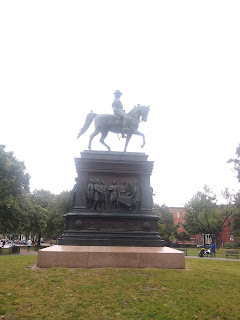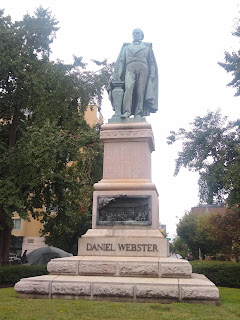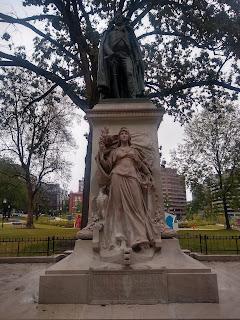 |
| Franklin School (1869) with a tiny Benjamin Franklin on the roof (now Planet Word, 925 13th St NW) |
Washington, D.C. is a strange place, being at once a town with residents and businesses and such, a museum of national history, and a fortress around working government buildings. Last weekend, in town for a Washington Term advisors meeting, I experienced all three. Walking from my hotel on the southwest side to the program headquarters on the northeast side, I passed through the mostly-empty Capitol grounds, dotted with security guards and barricades.
But on to more inspiring matters!
Churches
 |
| Church of the Ascension and Saint Agnes (1874), 1217 Massachusetts Ave NW |
 |
| National City Christian Church (1930), 5 Thomas Circle NW |
 |
| cupola at National City Christian |
 |
| Luther Place Memorial Church (1860s), 1226 Vermont Ave NW |
Worshipers in these congregations included Presidents James A. Garfield, Theodore Roosevelt, and Lyndon B. Johnson.
These churches might not be as full as they used to be, but they continue to perform vital ministries. National City Christian, for just one example, lists on its webpage refugee and immigration ministry, food pantry, youth ministry, and an LGBTQ community, in addition to weekly worship services. Both Luther Place and Ascension/Saint Agnes were promoting upcoming blessings of the animals.
 | |
 |
| Mt. Olivet Lutheran Church (1883), 1306 Vermont Ave NW (formerly Vermont Avenue Christian Church) |
 | ||
| Community Church (1903), 1405 15th St NW (formerly Grace Reformed Church) |
Memorials
 |
| Civil War: General George H. Thomas (1816-1870) in Thomas Circle |
 |
| civil rights: Mary McLeod Bethune (1875-1955) Council House, 1318 Vermont Ave NW |
 |
| Civil War: General John A. Logan (1826-1886) in Logan Circle |
 |
| 27 years in Congress: Daniel Webster (1782-1852), 1301 Bataan St NW |
...genuinely American and genuinely new. It has its own prophets and its own martyrs, its own sacred events and sacred places, its own solemn rituals and symbols.... It does not make any decision for us. It does not remove us from moral ambiguity, from being, in Lincoln's fine phrase, an "almost chosen people." But it is a heritage of moral and religious experience from which we still have much to learn as we formulate the decisions that lie ahead (1966: 18-19).
As a visitor, I am regularly reminded that I am part of an ongoing American project... I don't know if residents get used to it?
There were other things to notice as I walked around with Frommer's. Franklin Square, northwest of downtown Washington, features these whimsical seats:
I passed the Hungarian Embassy, which I include because I'm obsessed with embassies:









No comments:
Post a Comment